

Flora and Fauna of the Libyan Desert
| SEE ALSO: |
|
The Libyan Desert is one of the aridest places on earth. In places decades may pass without any rain, and even in the highlands rainfall happens erratically, once every 5-10 years. At Uweinat, the last recorded rainfall was in September 1998. With such dryness, one would expect the desert to be totally lifeless. Yet there is a surprising abundance of lifeforms, sometimes in the most unexpected places.
In the northern part of the Great Sand Sea (50-100 km south of Siwa) one may find clusters of a sturdy shrub, Calligonum commosum, incredously growing out of the sand far above any permanent water table. How it survives is a mystery, it must capture the very meagre moisture from the air.
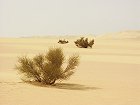
|

|
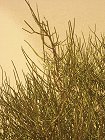
|
||
|
A colony of Calligonum commosum among dunes in the Great Sand Sea, about 70 kilometres south of Siwa (the southernmost vegetation noted among the dunes) |
||||
Further south plant life outside the oasis depressions is strictly limited to the bed of the larger wadis of the uplands and mountains. The dominant tree is Akacia raddiana, intermingled with fewer Akacia tortilis. (The former has a single thick trunk and erratic, generally rounded foliage, while the latter branches at ground level, and has a characteristic flat top).
There is a further akacia species, the low bush-like Akacia ehrenbergiana growing at the sandy bottom of wadis. Probably the solitary group of bushes in a small depression near the airfield at Wadi Sora, and the low dome shaped akacias encountered in the main wadi of the "Unnamed Plateau" belong to this species.
Aside the akacias Maerua crassifolia lives in the upper reaches of the wadis of both Uweinat and the Gilf Kebir, and we have noted a single tamarisk Tamarix nilotica (?) growing near the spring at Jebel Arkenu.
A bright green leaved Ficus species grows only in the upper reaches of Karkur Ibrahim at Jebel Uweinat, at an altitude between 800-1000 metres, in sheltered shady spots at the bottom of the deep and narrow wadi. The vegetation along wadi beds reaches up all the way to the summit, we have noted a solitary Maerua crassifolia at the head of a small wadi just under the peak at an altitude of 1800 metres. The highest elevation plant noted was a heavily grazed Fagonia thebaica just 70 metres under the summit.
The bottom of the wadis and karkurs support a number of grasses and shrubs. The grass Panicum turgidum grows in tufts, and covers much of the valley floors among the akacias at Uweinat. The shrub Zilla spinosa grows in dome like clusters, and can stay green for several years after rains. It is more common in the valleys in the Gilf Kebir. The "desert melon", Citrullus colocynthis grows in many lower lying areas of the wadis, usually at places where the rain runoffs end in shallow pools.
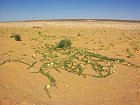
|
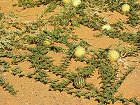
|
|
|
Ripening Citrullus colocynthys in a small wadi near Wau Namus |
||
In the low plateau to the north of Wadi Gubba in the Northern Gilf Kebir, we encountered a single example of a shrub, Cocculus pendulus that is common in the Sinai, Eastern Desert and Sahel, but it has been hitherto unreported from the hyperarid central Libyan Desert. It appears to be a very ancient plant, possibly a living fossil legacy of the earlier wetter periods, totally unexpected in the dry wadis that presently do not support any other trees or shrubs.
During the February 2003 expedition, we have encountered a colony of Salsola cyclophylla (? possibly S. tetragona) shrubs in another wadi of the same dry plateau north of Wadi Gubba. Salsola species have not been reported before in the central Libyan Desert. In the upper reaches of Karkur Talh at Jebel Uweinat, we found several examples of two species of blooming green shrubs, Pergularia tomentosa and Cleome droserifolia, perhaps the product of some very localised rains, that we have not seen before.
In October 2003, two shrub species were noted in a southern side wadi of karkur Ibrahim, both supporting fresh growth. They were subsequently confirmed as Fagonia thebaica, and Aerva persica, both common in the afro-arabian desert zone.
Fagonia thebaica may be encountered at totally unexpected places, where no other vegetation exists. A colony was noted in a sheltered sandy valley along the western cliffs of the Gilf, and is also abundant in the valleys of the Hassanein Plateau at Uweinat.
During our exploration of the Hassanein Plateau in March 2004, two plant species were noted which have not been seen elsewhere. Bright green Heliotropium bacciferum with white flowers were seen abundantly. Another low shrub was noted at a two location. Initially it was unidentified, but in March 2005 they were flowering, and this allowed their positive identification as Ochradenus baccatus.
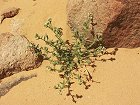
|

|
|
|
Heliotropium bacciferum seemed to be the dominant vegetation on the Hassanein Plateau together with Fagonia thebaica. |
||
After rains, the generally dry appearance of the wadis changes dramatically. Dormant seeds spring to life, and a few weeks after the rain bright green fresh growth and a multitude of flowers cover the bed of the watercourse. The pictures below were taken at Karkur Talh in November 1998, about two months after it rained.
It took seven years of patience to see this amazing transformation again. In October 2007, Karkur Talh and several other valleys were bright green once again. This time we were better prepared, and the aftermath of the rains are fully documented. About half of the plant species noted at Uweinat are only observable after rain. In the interim arid spells, the seeds lie dormant in the sand.
|
Click on image for detailed account of the 2005 rains aftermath
|
The vegetation around permanent water sources can be dramatically different. Date palms (Phoenix dactylifera) grow near any permanent water source, while the banks of any open water surface are covered by a dense growth of reeds (Phragmites australis, Imperata cylindrica). Depressions near the water table are dotted with "tarfa" mounds, growth of tamarisk (Tamarix nilotica) on elevated sand hills supported by the plant's roots. The plant captures and anchors wind blown sand, and constantly grows above it, reaching heights of 10-15 metres.
Animal life is the richest around vegetation, but amazingly one finds living creatures hundreds of kilometres from the closest plant and water. Even in the middle of the Sand Sea, the sand in the morning is covered by a multitude of tracks. In the daytime they are never seen, but at night the desert is alive.
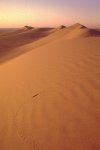
|
|
Tracks on a dune at dawn at the edge of the Great Sand Sea |
Insects are the most abundant, coming in all colors, sizes and flavors. The most abundant are the large black desert ants, that densely inhabit the akacia groves of Karkur Talh and the Gilf valleys, and incredulously butterflies, that seem to appear at any spot with the slightest green vegetation. In Wadi Hamra we did find a large spider that tried to make home in one of our cardboard boxes left out for the night, and encountered a fine exapmple of the same species in Karkur Ibrahim.
Scorpions do exist, but I have only encountered them near oases, not in the deep desert. One was seen near dakhla Oasis, having crawled under a tent. Another beautiful yellow Leirus quinquestriatus was seen in the Great Sand Sea south of Siwa. Per unit it's venom is more potent than that of a Cobra, however the amount of poison is so small that a sting is very rarely fatal for adult humans.
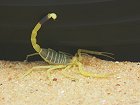 |
|
Freshly molted Leirus quinquestriatus, the deadliest of all scorpion species. |
Many lizards live near vegetation in the NE Gilf Kebir valleys. The underside of the large Zilla spinosa bushes are an especially favored home.
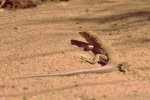
|

|
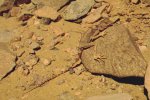
|
||
|
Lizard, Acanthodactylus scutellatus in Wadi Abd el Melik |
A. scutellatus under a Zilla spinosa in Wadi Hamra |
An Agama mutabilis in the main wadi of the "Unamed Plateau" north of Uweinat |
Snakes are abundant, but mostly their tracks and moulted skins are seen only. Tracks are frequent in areas far from any vegetation, even in the Great Sand Sea. They hide well among the rocks, only the trained eyes of Salama, our bedouin driver spotted them in places where we only saw rocks.
During October 2003 it was unseasonably hot, with daytime temperatures nearing 40. This time we saw more snakes, than during all previous trips combined, all of them sand snakes (Psammophis schokari).
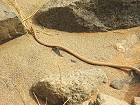 |
 |
 |
There are few permanent bird inhabitants. The most common is the "Zarzur" or White Crowned Wheatear (Oenanthe leucopyga), which is common all accross the Sahara. White wagtails (Motacilla alba) are also relatively frequent. As many of the great bird migration routes pass over the Libyan Desert, there are a great number of visiting species, and one may find many mummified corpses - the ones that did not make it accross the grueling route.
The few mammals that manage to survive in the great aridity are scarce and nocturnal, thus usually only their tracks are seen. The most common are various species of gerbils (Gerbillus) and jerboas (Jaculus) whose little padded feet and long tails leave distinct tracks in the sand. I've sat by the tripod, flash charged and bait set, for many hours during several nights, and none showed. In the morning when I woke up, the area around the tent was full of their tracks... Finally in march 2004 I've managed to take a few photos of a couple of gerbils at Wadi Sora.
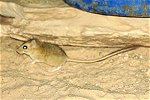 |
|
A Lesser Egyptian Gerbil, Gerbillus gerbillus at Wadi Sora |
There are many foxes in the valleys, not the cute fennec, but Rüppel's sand fox (Vulpes rueppeli), that can make a huge rattle with the empty dishes left around the camp fire after meals. They tend to be quite tame, and happily nibble away at left-over food in the blaze of torches shined at them from only a few metres away. Rarely they even approach a quiet camp in daylight. The photos below were taken at Karkur Talh in October 2002, from a distance of about 10 metres.

|
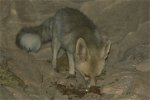
|
| Rüppel's desert fox, Vulpes rueppeli at Karkur Talh. Note the numerous black specks at it's feet, which are desert ants, Cataglyphis fortis. |
Only two species of larger mammals live(d) in the Libyan Desert. Dorcas gazelle (Gazella dorcas) inhabit the wadis on the plain to the south of Uweinat, and also live in the Karkurs. They have been hunted close to extinction by Italians and later the Libyans, but happily quite large numbers have found refuge in Karkur Talh, where they can often be seen in the early morning. The even rarer waddan, or barbary sheep (Ammotragus lervia) was relatively abundant in the Gilf and at Uweinat. Unfortunately indiscriminate hunting (primarily by poachers from Libya) have decimated their numbers, and today only the mummified corpses littering the wadis indicate their former presence, live sightings are very few. There is a particularly well preserved waddan mummy in Karkur Talh, obediently posing for visitor's cameras year after year.
On the southern borders, near the Wadi Howar region, the Addax antelope (Addax nasomaculatus), White oryx and Ostrich were once abundant, but it's doubtful whether any numbers still survive. In 1935 Mason even reported a family of lions living in the Wadi Howar, and Almásy had a rather frightening encounter with a cheetah in the same region. Almásy reported tracking an addax between Uweinat and the Gilf Kebir, and we have found ourselves a very old looking addax skeleton near Wadi Sora, proving once it's range included the central Libyan Desert.
For more saharan species, visit:
www.shara-nature.com

|

|

|